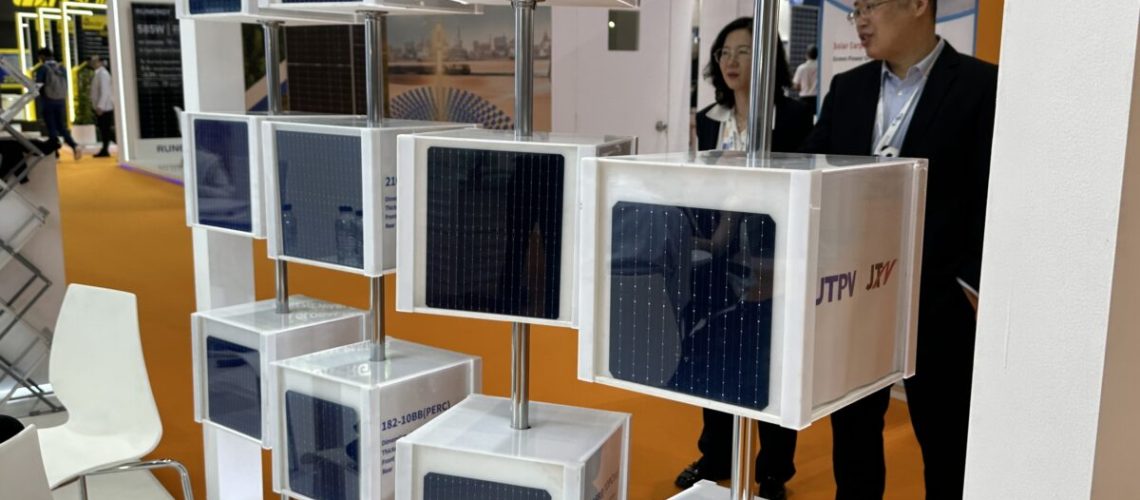Dutch researchers used dynamic modelling to uncover the demand for silicon-based PV materials used in a wide range silicon PV technologies, including perovskite-silicon tandem and back-contact modules. The model included calculating the impact of advances in module efficiency and material intensity, as well as circular closed loop recycling.
From pv magazine Global
A research group in the Netherlands used dynamic modeling to calculate demand for silicon-based PV materials in future scenarios that include deployment of perovskite-silicon tandem and back-contact technologies, and implies that the net-zero greenhouse gas emissions goals are being achieved. It included calculation with module efficiency and material intensity advances.
Looking at the exponential growth of solar power and silicon-based PV modules and the potential material demand, the group asked the question of how much of an influence PV technology choices could have on demand for materials like indium and silver.
To find the answers, the team used a dynamic material flow analysis (dMFA) model specifically developed for silicon-based PV. The dMFA methodology that they used captured future annual dynamics in PV deployment capacity, module efficiency, material compositions, and market shares for various PV technologies.
“The most interesting aspect of the research is the model itself, which includes annual dynamics in PV deployment capacity module efficiency material compositions and market shares for various PV technologies until 2050,” the lead author of the research, Chengjian Xu, told pv magazine.
In its modeling, the group identified potential shortages of silver and indium but also that technological advances, such as improved PV module efficiency and reduced material mass per module area, are an opportunity to affect demand. For example, the annual demand for PV module materials, such as silicon, aluminum, silver, and other materials, could be reduced by 46%, 35%, 30%, and 13% respectively, compared to scenarios without such improvements. Furthermore, closed-loop recycling may reduce material demand by 10% to 30%.
The model included a range of silicon PV technologies: aluminum back surface field (Al-BSF), passivated emitter and rear contact (PERC), tunnel oxide passivated contact (TOPCon), silicon heterojunctions (SHJ), interdigitated back contact (IBC), and perovskite-silicon tandem, in four-terminal (4T) and two-terminal (2T) tandem variations.
“This study provides a more comprehensive technology roadmap compared to existing ones, which often focus on a limited number of technologies and overlook the perovskite-silicon tandem,” said the researchers.
The efficiency limitations were set at 20% for Al-BSF, 24% for PERC, 26% for both TOPCon and SHJ, 26.5% for IBC, and 39% for perovskite-silicon tandem modules. Higher efficiency for bifacial PV modules was taken into account.
Historical PV deployment capacity data from 2000 to 2022 was sourced from the International Renewable Energy Agency (IRENA). Two future PV deployment scenarios were used, one from the International Energy Agency (IEA), representing the conservative PV scenario, and an optimistic scenario, based on predictions made in 2021 by another research team. Both had the goal of achieving net-zero emissions by 2050.
For technology selection, the team used data from the International Technology Roadmap for Photovoltaic (ITRPV) to 2030 and further extrapolated it out to 2050 by incorporating estimates from other sources.
The results for the period from 2022 to 2050, indicated demand for indium could increase between 38 and 286 times the status quo, silver by 4 to 27 times, with other materials’ demand increasing by 2 to 20 times, depending on the PV deployment scenario.
“Indium and silver demand are notably influenced by PV technology choice,” said the researchers. Cumulative indium demand over the period 2022–2050 could range from 0 kt in a 100% PERC and TOPCon scenario to 209 kt in a 100% perovskite-silicon four-terminal tandem PV. Cumulative silver demand during the same period could vary from 144 kt in a 100% PERC PV scenario to 1121 kt with 100% silicon heterojunction PV penetration.
They also stressed that improvements in material intensity may reduce the annual demand for PV module materials by 46% for silicon, 35% for aluminum, 30% for silver, and 13% for other materials, compared to scenarios without such improvements.
In addition, they said, “One promising approach to mitigate the increasing demand for primary materials is closed-loop recycling. By implementing efficient PV collection and recycling processes, cumulative primary material demand could be reduced by 10% to 30% between 2022 and 2050.”
The research is detailed in “Future material demand for global silicon-based PV modules under net-zero emissions target until 2050,” published by Resources, Conservation and Recycling. The study participants were from Delft University of Technology and Leiden University.
Looking ahead, Xu said plans are in place to update the technology roadmap data and further extend the scope of the research to include relevant balance of system component material demand in future scenarios.



